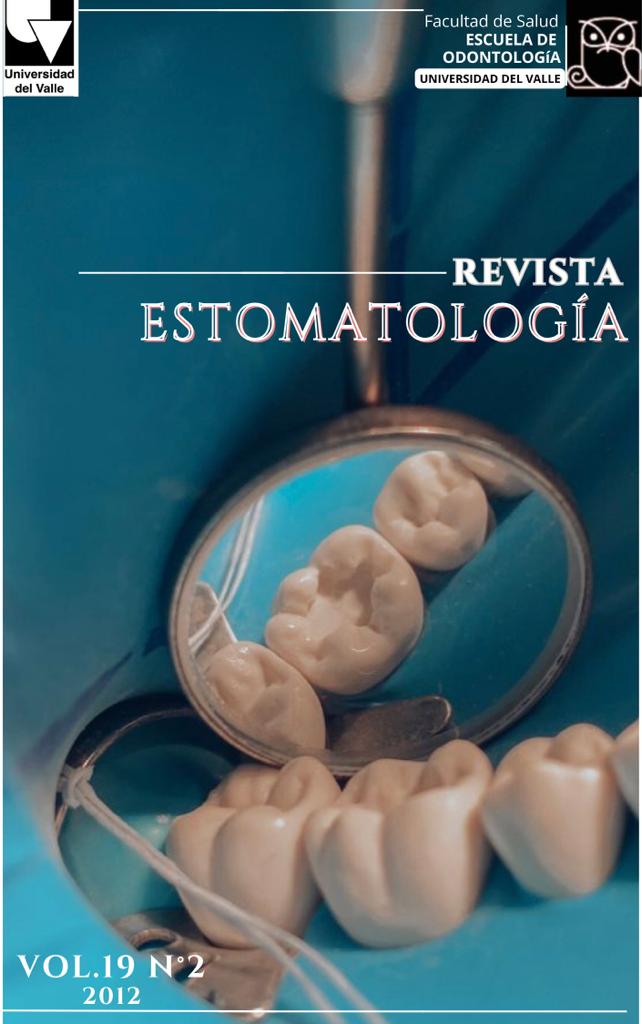Characterization of occlusal relationships and arch dimensions in sagittal, transversal and vertical planes in primary and early mixed dentition in schoolchild of Manizales
Main Article Content
Objective: To characterize oclussal relationships in primary and early mixed dentition and arch dimensions in sagittal, transversal and vertical planes.
Materials and methods: This descriptive study considered a convenience sample of 107 children with an average age of 5.69 years (59 girls and 48 boys) registered in ten schools. Panoramic and cephalometric radiographs and study models were taken according to validated protocols. Panoramic radiographs showed the position and angulation of the first permanent molars.
Results: 84% of patients in the study were characterized by having complete dentition, having a left and right molar relationships in flat terminal plane, an increased vertical overbite, an anterior superior width in a range between 27 and 32 mm, a superior posterior width between 32 and 39 mm, an anterior inferior width between 22 and 27 mm and an inferior posterior width between 39 and 46 mm. The inclination angle of the first superior molar is between 25 and 36 degrees.
Conclusion: Most patients had arch dimensions and canine and molar relationships within the normal parameters as reported in the literature. Increased overbite and overjet in vertical and horizontal planes were found. In primary dentition, flat terminal plane and Class I canine relationship predominated. Only in 16 patients was applicable permanent molar relationship, of which 9 had class II.
- Molar relationship
- occlusal relationship
- arch dimensions
- primary dentition
- mixed dentition
2. Baume LJ. Physiologic tooth migration and its significance for the development occlusion. Part I. J Dent Res 1950; 29(3):338-48.
3. Bishara SE, Hoppens BJ, Jakobsen JR, Kohout FJ. Changes in the molar relationship between the deciduous and permanent dentitions: a longitudinal study. Am J Orthod Dentofacial Orthop 1988; 93 (1):19-28.
4. Moorrees CF, Gron AM, Lebret LM, Yen PK, Fröhlich FJ. Growth studies of the dentition: a review. Am J Orthod 1969; 55(6):600-16
5. Arslan SG, Kama JD, Sahin S, Hamamci O. Longitudinal changes in dental arches from mixed to permanent dentition in a Turkish population. Am J Orthod Dentofacial Orthop 2007; 132(5):576.e 15-21.
6. Baume LJ. Physiologic tooth migration and its significance for the development occlusion. Part I-II. J Res 1950; 29(2):123- 32.
7. Ministerio de Salud de Colombia. Resolución 8430 de 1993.Normas científicas, técnicas y administrativas en investigación en salud.
8. Tatis DF. Análisis cefalométrico de Tatis para radiografia panorámica. Tame Editores, Cali Colombia 2007; pag.19
9. Proffit, WR, Fields, HW,Jr, Sarver, DM. Ortodoncia Contemporanea. 4 edición. Elsevier Science Health Science Div – España. 2008
10. Baume LJ.Physiological Tooth Migration and its Significance for the Development of Occlusion : III. the Biogenesis of the Successional Dentition. J Dent Res 1950; 29: 338
11. Bishara Samir E et al. Changes in the molar relationship between the deciduous and permanent dentitions: A longitudinal study. Am J Orthod Dentofac Orthop 1988; 93:19-28. InTsai HH.Tooth-position, arch-size, and arch-shape in the primary dentition.ASDC J Dent Child 2001; 68(1):17-22. Figura 1. Distribución de la población de acuerdo con las tres clases resultantes en el análisis multivariado. 23 Revista Estomatología y Salud
12. Peña Serrato Lucia. Estudio epidemiológico de salud y maloclusión dental en niños de Bogotá. Universidad Nacional de Colombia Sede Bogotá; 2002.
13. Björk A, Skieller V. Facial development and tooth eruption. An implant study at the age of puberty. Am J Orthod 1972; 62(4):339-83.
14. Baccetti T, Franchi L, McNamara JA Jr, Tollaro I. Early dentofacial features of Class II malocclusion: a longitudinal study from the deciduous through the mixed dentition. Am J Orthod Dentofacial Orthop 1997; 111(5):502-9.
Downloads
Los autores/as conservan los derechos de autor y ceden a la revista el derecho de la primera publicación, con el trabajo registrado con la licencia de atribución de Creative Commons, que permite a terceros utilizar lo publicado siempre que mencionen la autoría del trabajo y a la primera publicación en esta revista.





